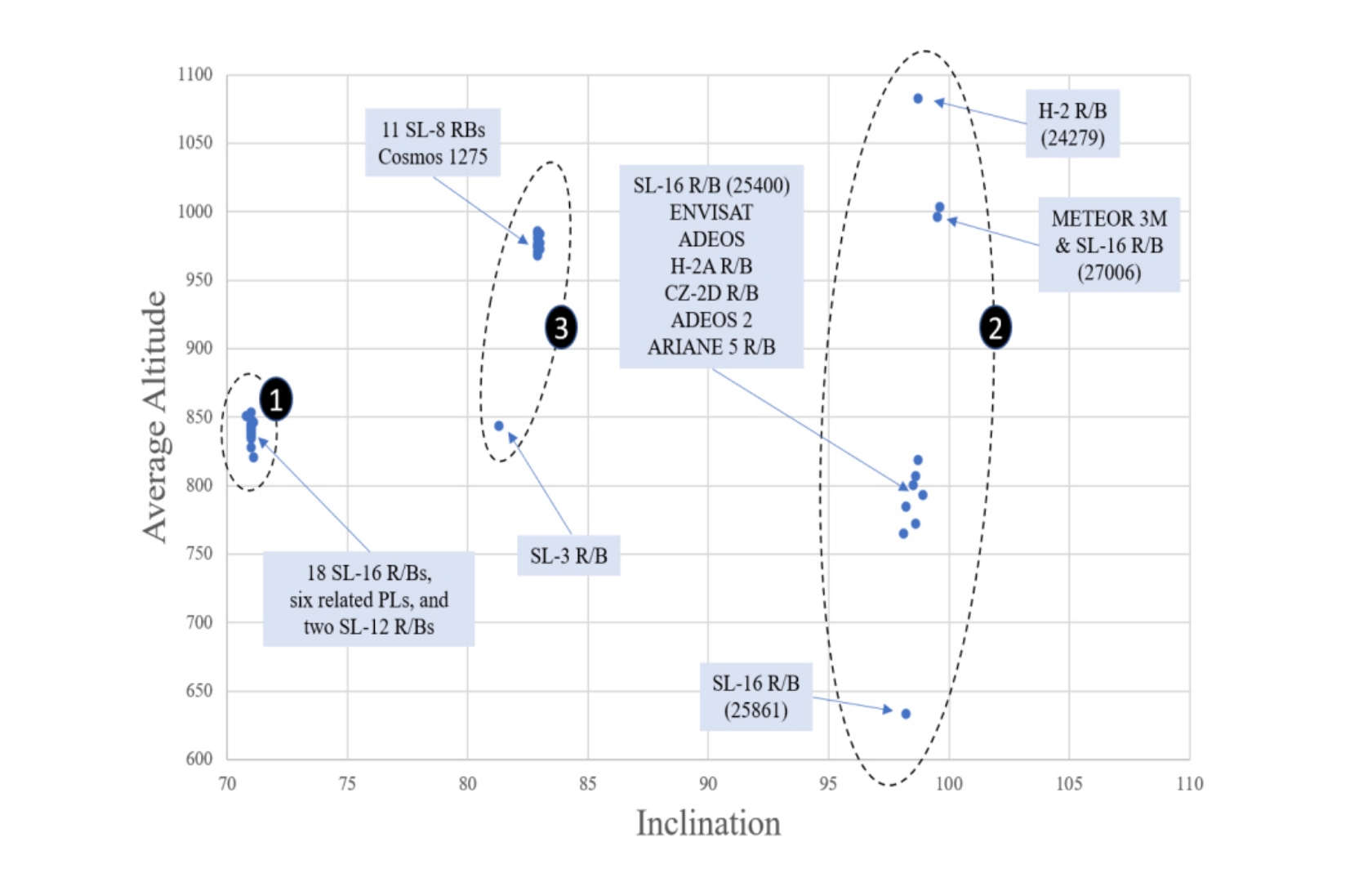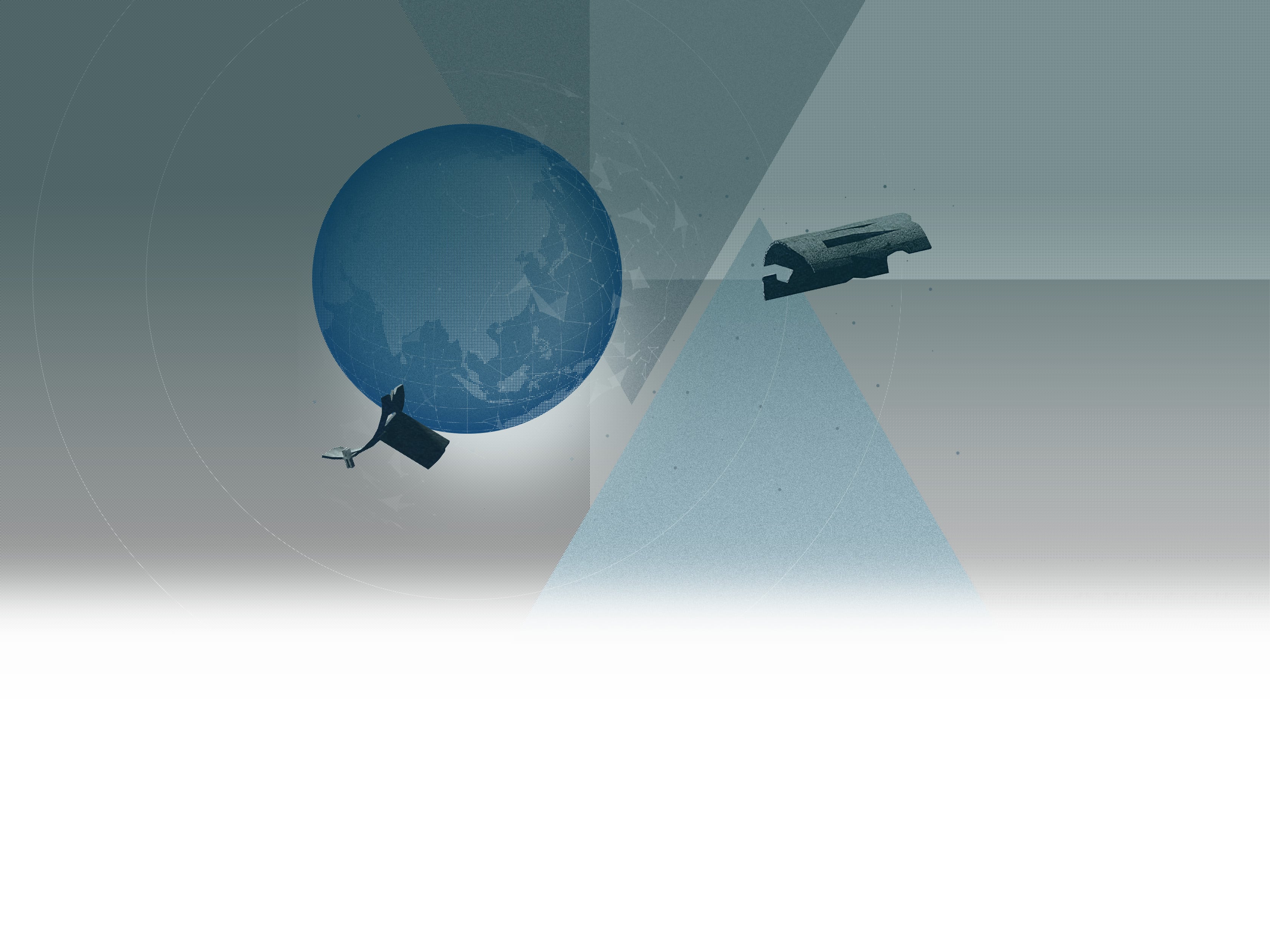used to maintain the orbital environment
around the Earth in which satellites fly.
The following items are explained in this site.
What is space debris?
Definition and overview of space debris.
Space debris is unused man-made objects in Earth orbit, such as rockets and satellites that have served their purpose, or objects that have separated from these objects.
Space debris flies around the Earth at a speed of approximately 28,000 km/h. For example, a 1.3-cm-diameter aluminum ball (with a mass of about 3 g) can penetrate a 5-cm-thick aluminum plate when it hits at this speed. (NASA Hyper Velocity Impact Team factsheet, etc.)
Accidents are now occurring in space where debris collides with satellites, causing them to lose their functionality. In order for mankind to continue to utilize space, it is important to reduce space debris and protect the orbital environment.
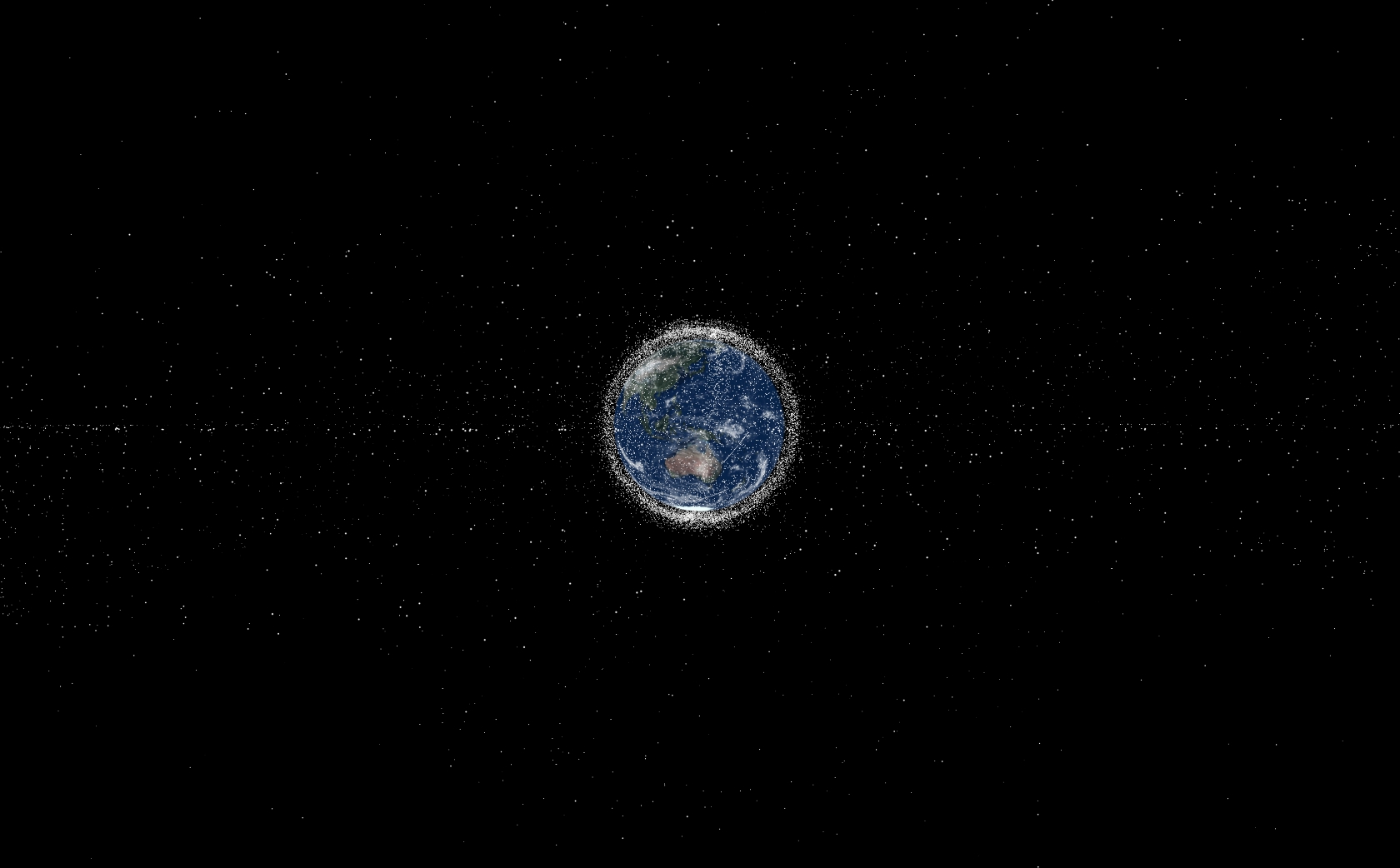
Space debris: current status and issues
and is expected to increase in the future.
Why is it increasing? What is the mechanism?
Current status of space debris
The current space debris situation, including spent rocket upper stages, satellites, and debris, is increasing every year.
The United States tracks objects with a representative length of more than about 10 cm in low orbit and more than about 1 m in geostationary orbit through its ground-based observation network, and discloses such orbital information to the world with the exception of military satellites, etc. The figure shows the number of cataloged objects (objects identified in the U.S. and whose orbits, etc. have been confirmed) released to the public in the U.S. You can see that the number is increasing year by year.
Based on ground-based observations and modeling (ESA MASTER8, etc.), it is estimated that there are 500,000 to 900,000 pieces of debris with a representative length of 1 cm or more, and more than 100 million pieces with a length of 1 mm or more. Since 1957, there have been approximately 6,000 launches of objects, more than 300 anomalous events in which some object was ejected from an orbiting object (including more than 200 explosive events in which objects were ejected at high speed), and five collisions between cataloged objects. (NASA Orbital Debris Quarterly News Volume 25, Issue 4, ESA'S ANNUAL SPACE ENVIRONMENT REPORT, etc.)
Satellite constellation programs are about to be implemented in many countries, in which multiple satellites (100~10,000 or more) are placed in orbit for communication and earth observation. The STARLINK project is well-known for the project being implemented by the U.S. company Space-X. 2,352 STARLINK satellites are already in operation in orbit(As of May 20, 2022), and the plan is to eventually launch 42,000 satellites (National Institute of Information and Communications Technology, National Institute of Information and Communications Technology, "Trend Report on the U.S. Satellite Constellation Program"). The light blue line in the figure represents the number of satellite objects, which has been rapidly increasing since around 2019 due to the launch of these constellation satellites.
The number of objects launched by humans since Sputnik in 1957 is approximately 10,000, and the orbital environment is expected to change rapidly in the future due to the Constellation Program, which will launch satellites far exceeding the number of objects launched by humans to date in the next few years.
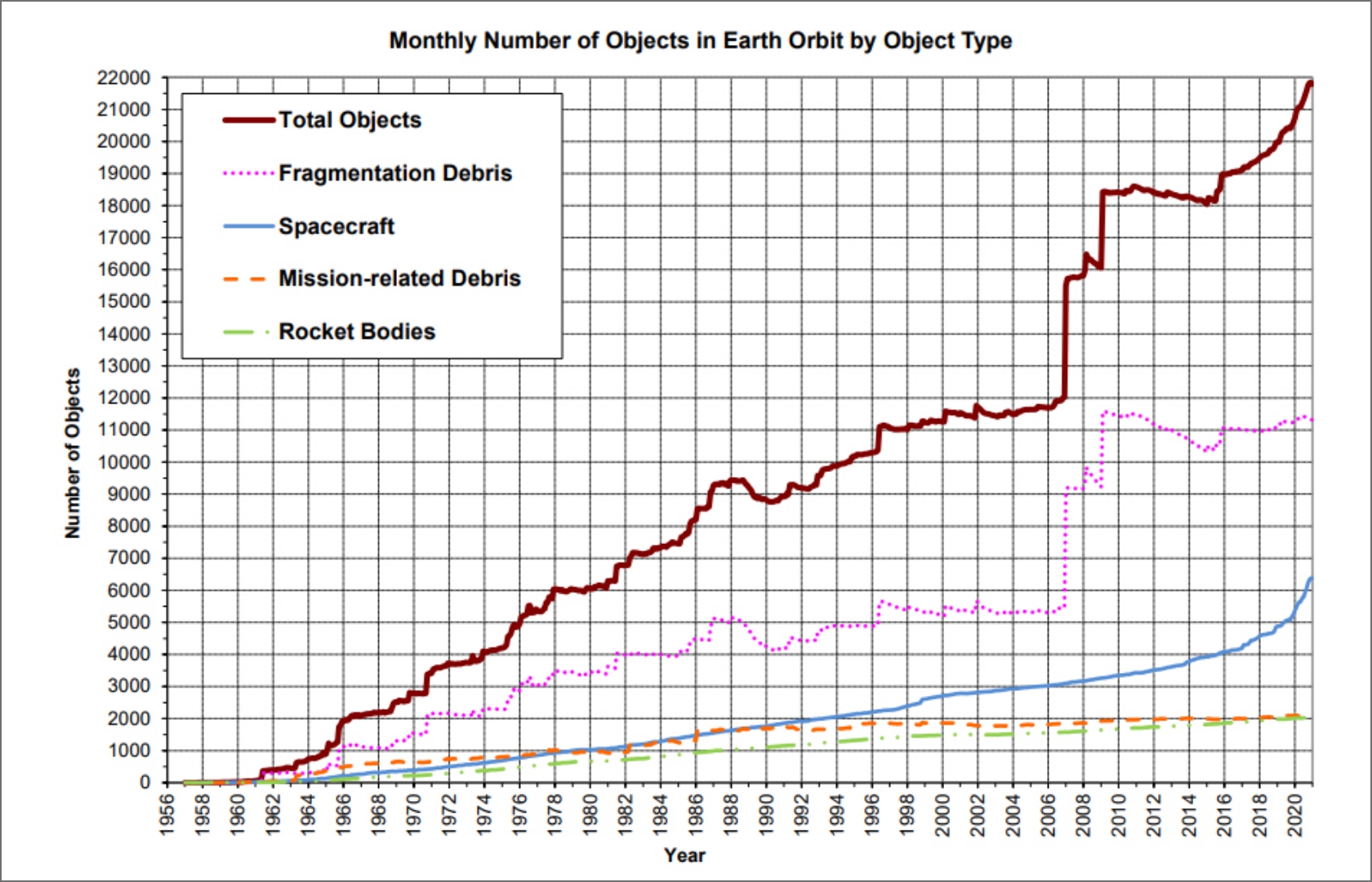
Mechanism of
Space Debris Increase
The launch of a rocket or satellite increases the amount of material in orbit. On the other hand, some objects already in low orbit gradually lose orbital altitude due to atmospheric drag and eventually re-enter the atmosphere, and upon re-entry, the amount of material in orbit is reduced. The subtraction of the increase and reduction results in a change in the amount of suborbital mass. The figure shows the change in the mass of the orbiting objects and shows that it is increasing steadily year by year.
The number of orbital objects is further increasing, as shown in the Current Status of Space Debris section. The number of objects increases when already existing orbital objects collide with each other or when individual orbital objects are crushed by some other factor. The sharp increase in 2007 was the result of a Chinese satellite destruction experiment, and the sharp increase in 2009 was the result of collisions between operational satellites and satellites that had been left in orbit after their operations had ended. The satellite destruction experiment conducted by Russia in 2021 has generated more than 1,700 pieces of debris as of 5/20/2022.
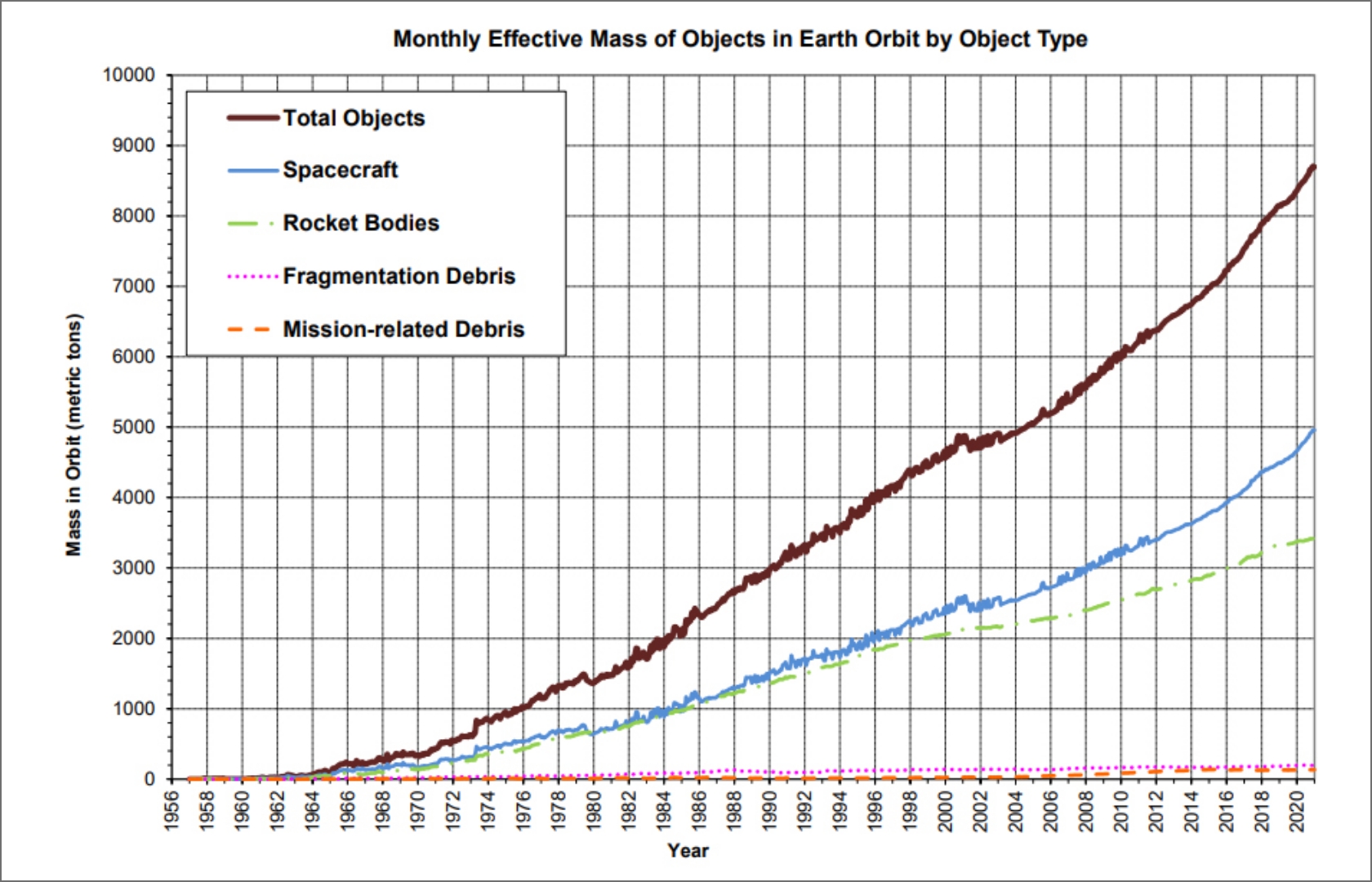
Future Projections of
Space Debris Numbers
Space debris is expected to increase even if space activity were to cease.
According to the IADC (Inter-Agency Space Debris Coordination Council), in which 13 space agencies around the world (Japan, the U.S., Europe, etc.) participate, even if we achieve a 90% post-mission disposal (PMD) rate, in which spacecraft to be launched in the future de-orbit after the end of operations, and make efforts to prevent debris from being produced, it is shared by many space agencies that the space debris environment will deteriorate due to the existing space debris collisions and other factors. (The current PMD implementation rate for satellites with an on-orbit lifetime of more than 25 years is about 20-40%, and the assumption of a 90% implementation rate in the future is a rather optimistic prediction. (Kawamoto, et. al “Evaluation of Space Debris Mitigation Measures Using a Debris Evolutionary Model”, Trans. JSASS Aerospace Tech. Japan Vol. 16, No. 7, pp. 599-603, 2018 DOI: 10.2322/tastj.16.599)The figure shows the debris environment predictions presented by the six space agencies, assuming a PMD implementation rate of 90%. It shows a trend of increasing debris numbers on average. Therefore, at a minimum, even if the current debris count is maintained, PMD alone is not sufficient.
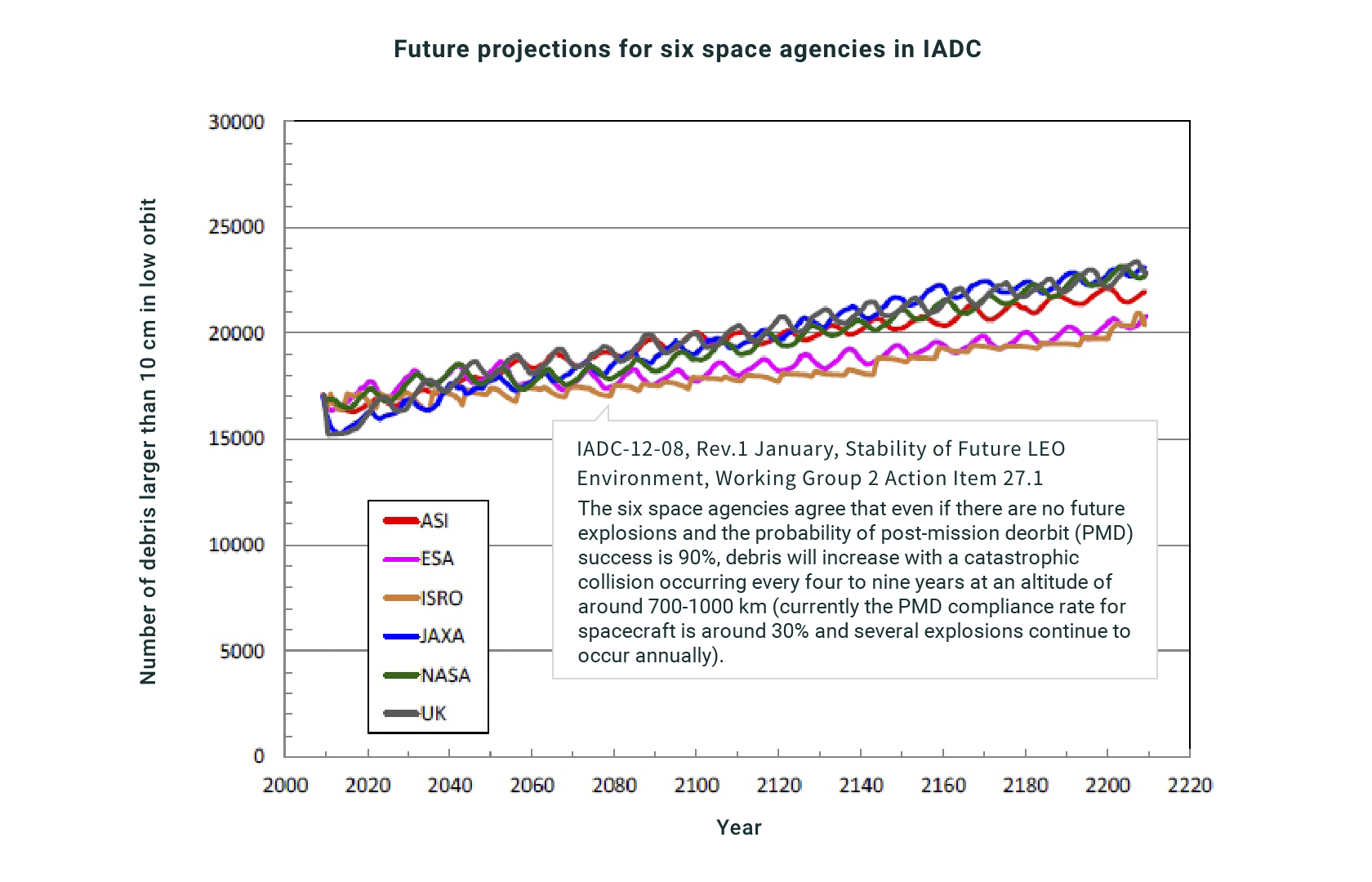
The following figure shows the results of a simulation of PMD compliance and its impact on the future: the red line for no PMD at all shows a 4.3-fold increase in the number of objects in orbit over 200 years; even with a 90% PMD compliance rate, the number of objects in orbit would increase by about 2.1-fold over 200 years; with a PMD compliance rate of 90% and even if we assume that no single explosion event occurs in the future, the number of objects in orbit will increase by about 1.4-fold over 200 years, indicating that it will be difficult to maintain the orbital environment with PMDs alone.
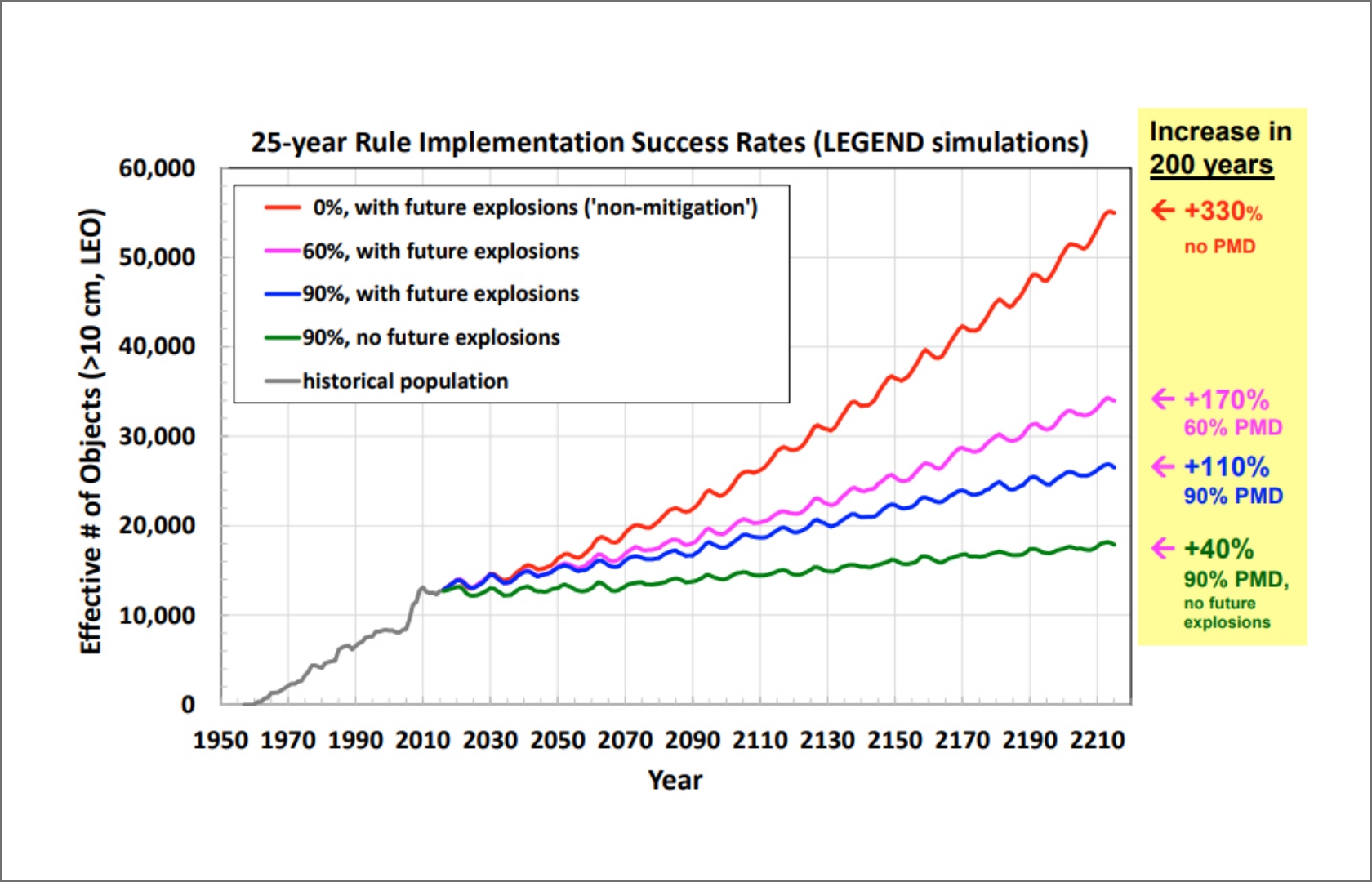
Countermeasures against space debris problem
"observation and prediction", "reduction of debris generation",
and "removal".
Countermeasures for
Various Space Debris Problems
Observation, modeling, prediction of space debris environment and reduction of its generation are important for the countermeasure for space debris problem.
01.Observation, modeling and prediction of space debris environment
Observation of the space debris environment is used to understand the current status and to avoid collisions in order to reduce the occurrence of space debris. Modeling and prediction of the space debris environment is also a technique that leads to an understanding of what measures will be effective in improving the environment.
02.Reduction
There are three possible means of reducing space debris generation: "suppression of occurrence," "collision avoidance/protection," and "active debris removal," and a combination of these three means is being studied to reduce the generation of space debris.
A.Suppression of Occurrence
Suppression of occurrence, for example, by de-orbiting the satellite after it has completed operations, rather than remaining in orbit, reduces the probability of future collision and fragmentation events. The method of de-orbit after the end of operations is called Post Mission Disposal (PMD), and the implementation of PMD is considered to be very important for environmental improvement.
Reducing the pressure of vessels such as fuel tanks and lowering the charging power of rechargeable batteries to prevent fracking from occurring after the end of operations reduce the probability of a fracking event occurring and is important for suppression of occurrence.
B.Collision Avoidance and Protection
Operational satellites should avoid colliding with debris, but it is impossible with current technology for a satellite to automatically detect debris that collides with its own satellite. Therefore, it is important to avoid collision when there is a high possibility of debris collision based on ground-based observations. The U.S. Department of Defense Strategic Command Integrated Space Operations Center alerts satellite operators of potential collisions when there are objects with representative dimensions of 10 cm or more that are likely to collide. The satellite operators analyze the orbit in more detail based on the alert and, if necessary, have their satellites perform collision avoidance maneuvers. The satellites operated by JAXA generally perform about five collision avoidance operations per year. The International Space Station (ISS) has performed 30 collision avoidance maneuvers over the 23 years from 1999 to 2022, temporarily changing its orbit.
It is also important to have defensive technologies to prevent the loss of satellite functions even in the event of a collision with minute debris with representative dimensions of 1 mm or less. The space station where astronauts are working is covered with a debris barrier called a debris bumper, which is designed to prevent accidents caused by collisions with microscopic debris.
C.Active Debris Removal (ADR)
Active Debris Removal (ADR) is the removal of debris already in orbit from orbit using dedicated satellites or other means.
As described in the Future Projections of Space Debris Numbers, even if almost all (e.g., 90%) of the satellites to be launched in the future perform PMD and deorbit, and no single fragmentation event of existing debris occurs, fragmentation will occur due to collisions between existing space debris, and the number of debris will increase. This phenomenon of debris increase due to chain collisions between debris is called the Kessler Syndrome. In this situation, the only way to improve the environment is to reduce the number and mass of existing debris by ADR.
In general, removing objects that are in orbits with high spatial density and large weight will help improve the orbital environment in the future. This is because the higher the spatial density, the higher the probability of collision events with other debris, and the greater the mass, the greater the number of debris fragments once they collide and shatter.
Space debris removal
What is the most effective
space debris removal method?
Predicted Effectiveness of
Active Debris Removal (ADR)
The figure shows the predicted number of debris in orbit if one to five pieces of large debris with a high probability of impact and the potential to generate a large number of debris fragments are removed each year. This transition model is also used to examine debris removal targets and mission requirements for debris removal. The model shows that the orbital environment improves when 5 pieces of large debris are removed per year. The removal of five to ten pieces of large space debris in crowded orbits per year is predicted to maintain an orbital environment similar to that of the current situation.
(cf.[Liou, 2011][Lewis, 2012][Kawamoto, 2020] etc.)
- Liou, J-C. “An active debris removal parametric study for LEO environment remediation.” Advances in space research 47.11 (2011): 1865-1876.
- Lewis, Hugh G., et al. “Synergy of debris mitigation and removal.” Acta Astronautica 81.1 (2012): 62-68.
- Kawamoto, Satomi, et al. “Impact on collision probability by post mission disposal and active debris removal.”Journal of Space Safety Engineering 7.3 (2020): 178-191.
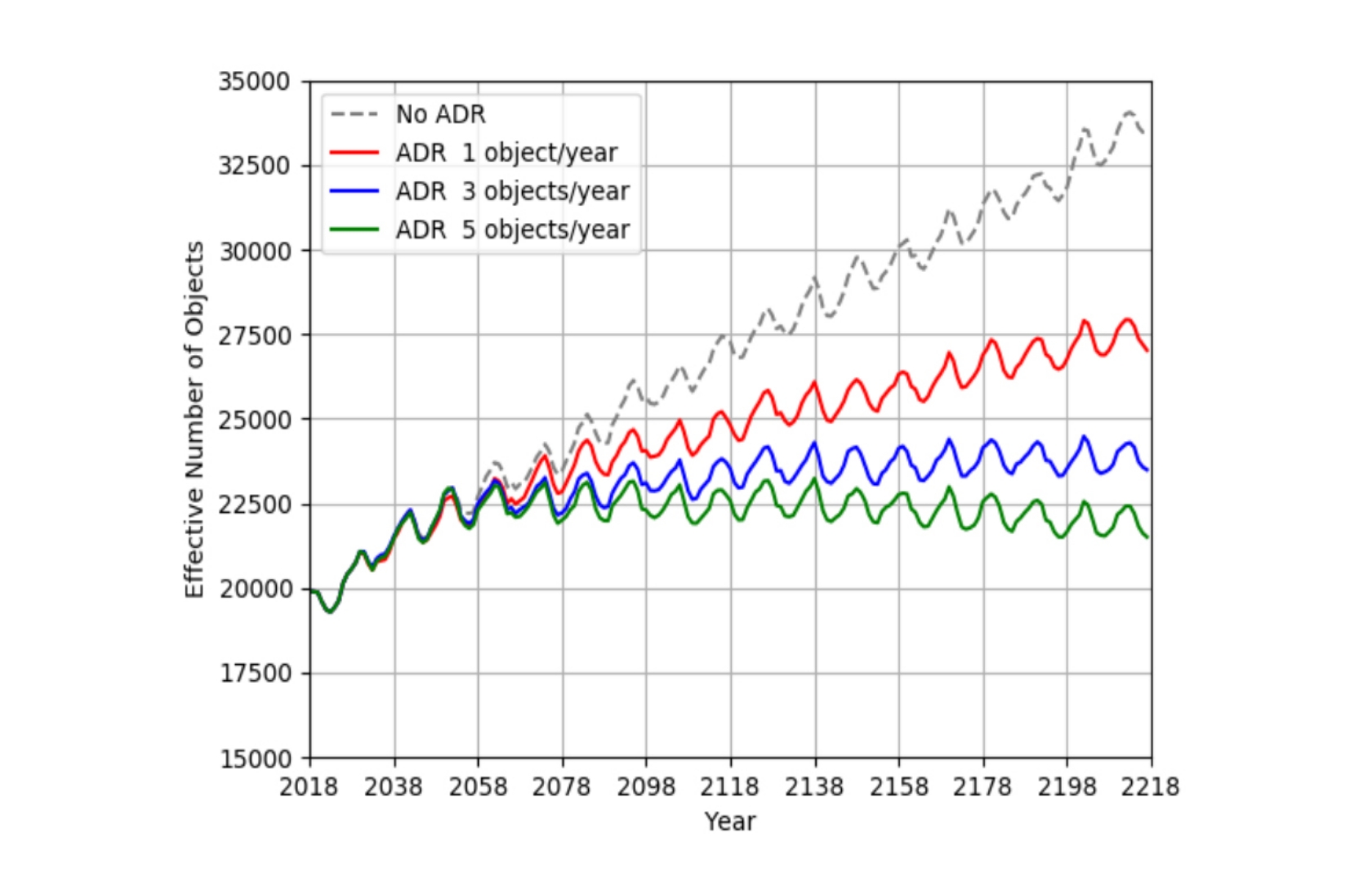
Highly effective
space debris removal
As we have discussed, the removal of objects with large dimensions and weight is effective in improving the orbital environment. We also know that removal of objects in crowded orbits, where there are many objects in similar orbits, is more effective. Based on these ideas, various lists of the top 50 debris that contribute to improving the debris environment in so-called low orbital regions below 2000 km altitude have been compiled. The figure shows these 50 debris classified by orbital elements (orbital inclination and orbital altitude). It is known that there is a bias for each orbital inclination angle and orbital altitude, and the orbital environment can be efficiently improved if these debris are removed intensively.
